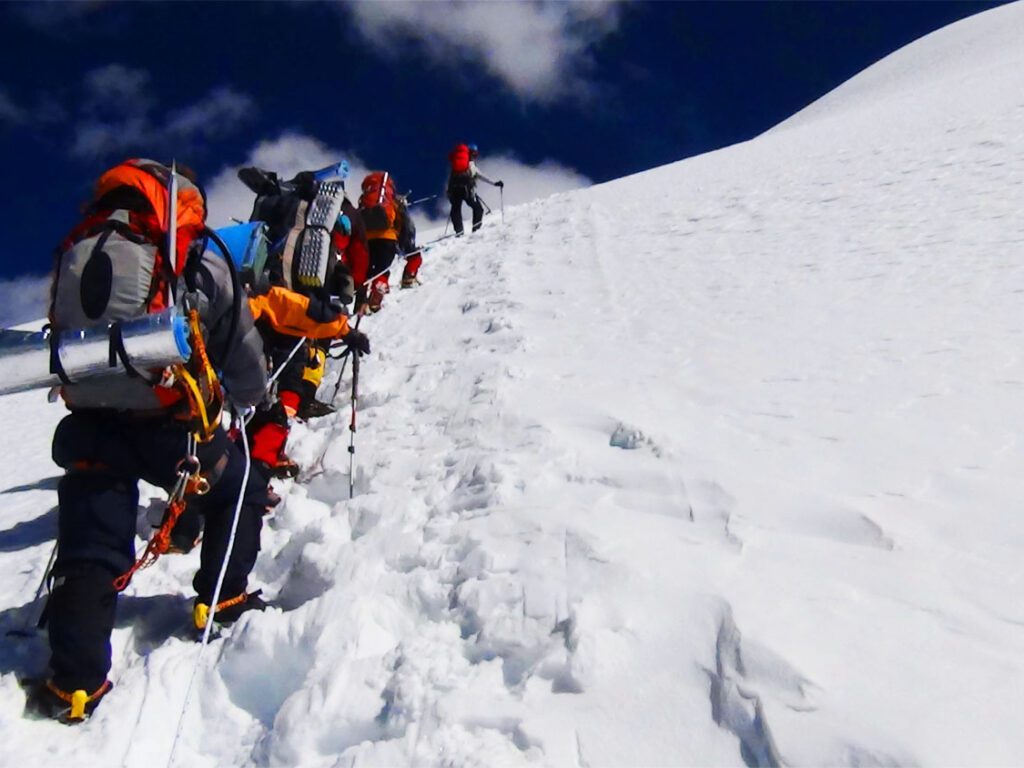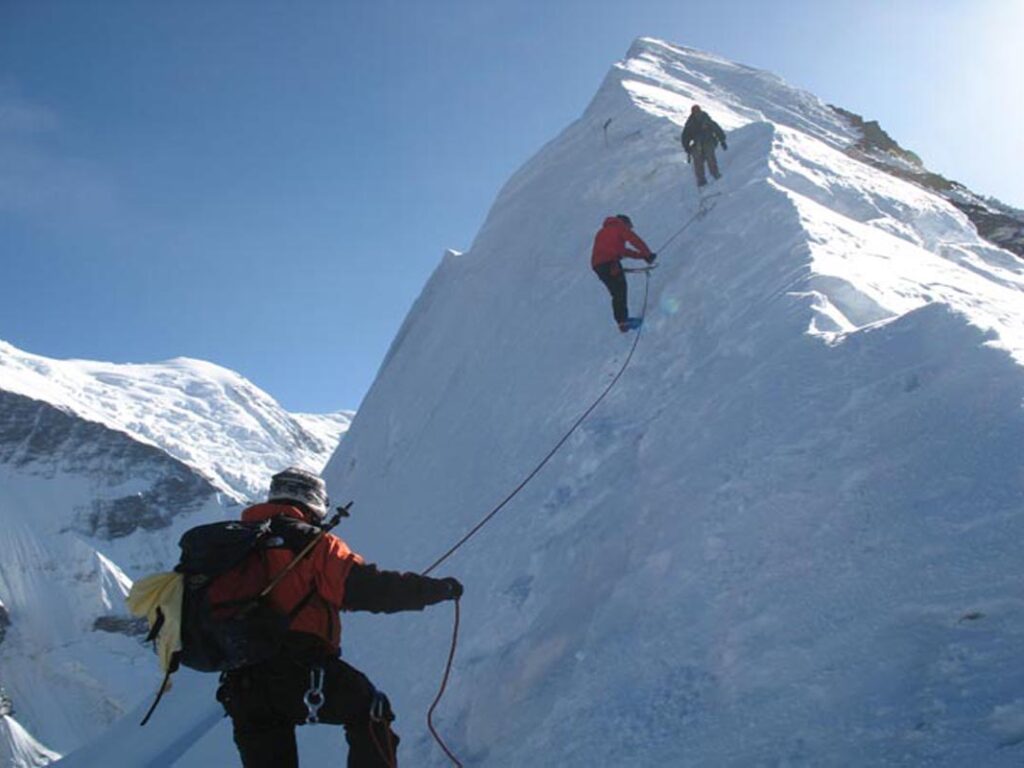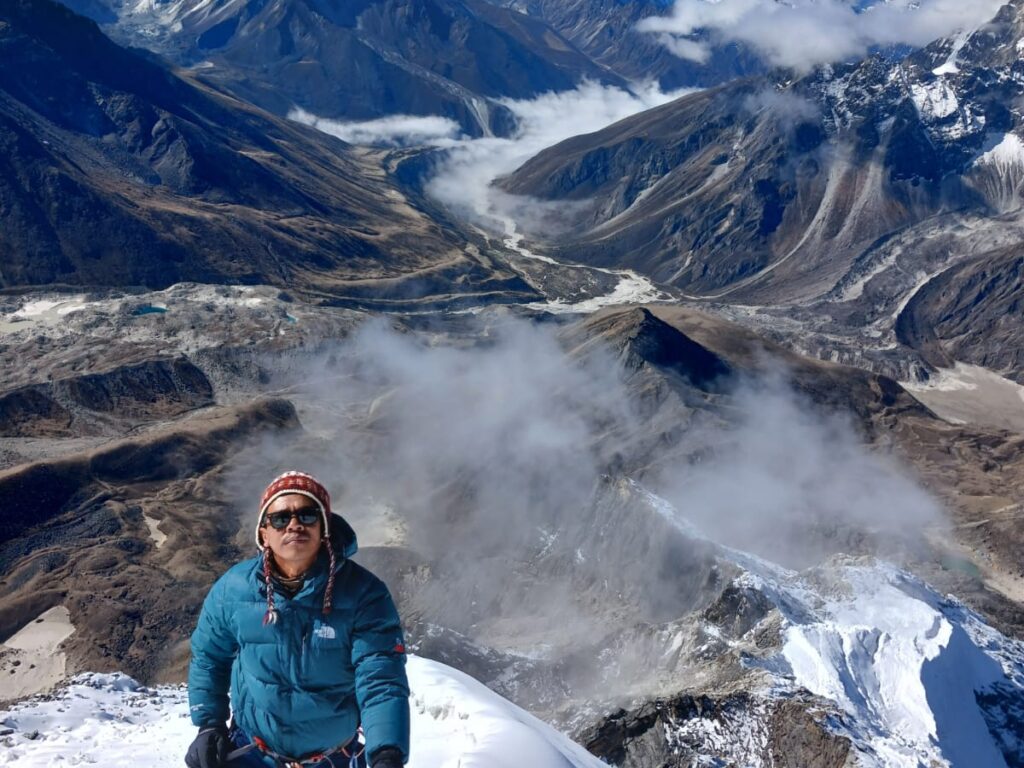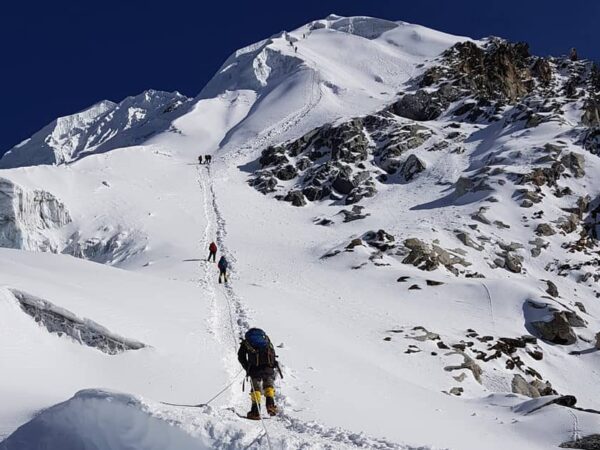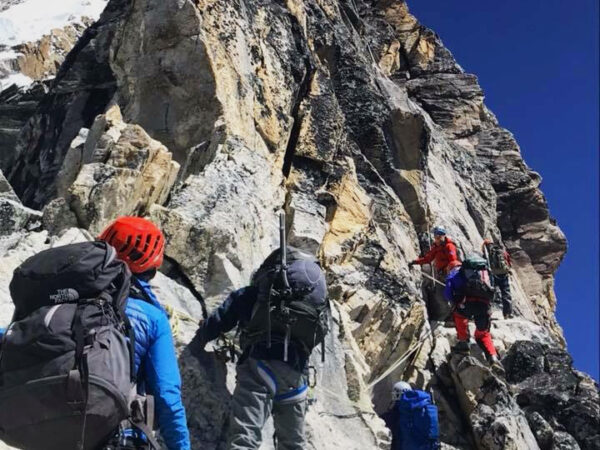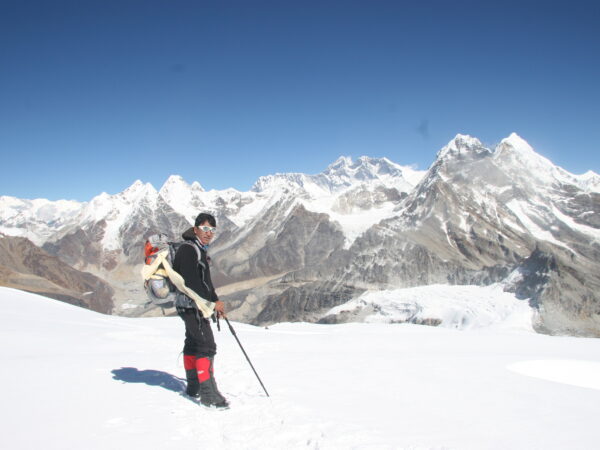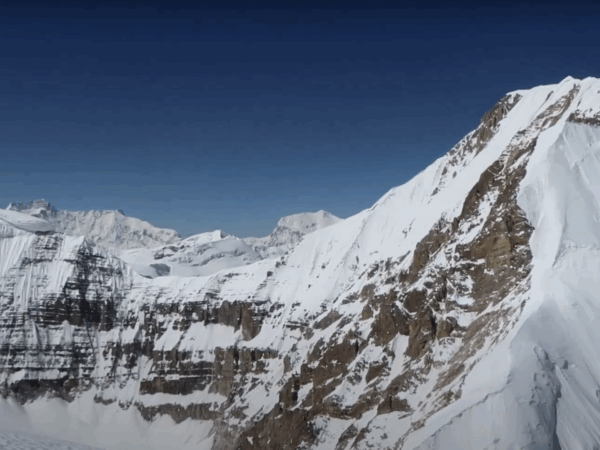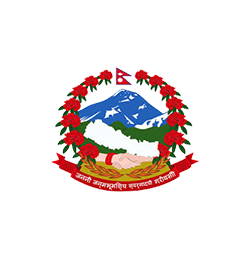Island Peak, also known as Imja Tse, stands at 6,189 meters (20,305 feet) in the Everest region of Nepal. Nestled in the stunning Chhukung Valley, this iconic peak is surrounded by towering Himalayan giants such as Lhotse, Nuptse, and Baruntse. Despite its impressive height, Island Peak appears like a small island rising from a glacial sea—hence its name.
Highlights
- Magnificent view of high Himalayan mountains- Everest, Lhotse, Cho Oyu, Nuptse, Mt. Ama Dablam, etc
- Explore EBC 5364 m and hike to Kalapathar 5545 m.
- Summit the Island Peak 6189 m
- Get opportunity to visit Sherpa Villages and Museum
- Flora and Fauna of Sagarmatha National Park
- Walking along the bank of Dhudh Koshi River
- Take a spooky flight to Lukla
Why Climb Island Peak?
The Island Peak expedition offers an exciting yet challenging experience for climbers seeking their first 6,000-meter Himalayan summit. The climb is both demanding and rewarding, offering breathtaking views of Mount Everest, Makalu, Ama Dablam, and other towering peaks.
Notably, in 1953, Sir Edmund Hillary and Tenzing Norgay Sherpa used Island Peak as a training ground before their historic ascent of Mount Everest. Today, it remains a popular peak for acclimatization and preparation for higher Himalayan expeditions.
Island Peak and the Everest Base Camp Trek
Island Peak is often combined with the Everest Base Camp trek, allowing climbers to experience the legendary Khumbu region while preparing for the summit push. The journey takes you through picturesque Sherpa villages like Namche Bazaar, Tengboche, and Dingboche, with breathtaking views of the Khumbu Icefall and surrounding glaciers.
Is Island Peak Climbing Difficult?
Island Peak is classified as a trekking peak, making it accessible to aspiring mountaineers with basic climbing skills. However, the ascent involves semi-technical climbing, including:
- Steep ascents with fixed ropes
- Glacier crossings requiring ice axes and crampons
- A final 45-degree ice wall climb to the summit
Proper training, acclimatization, and expert guidance are essential for a successful climb.
Best Time to Climb Island Peak
The ideal seasons for Island Peak climbing are:
✔ Spring (April-May) – Stable weather, clear skies, and warmer temperatures
✔ Autumn (September-November) – Crisp views, dry conditions, and less snowfall
These months offer the best chances of a successful summit with safer climbing conditions.
Local Culture & Sherpa Hospitality
The Khumbu region is home to the brave Sherpa and Rai communities, who are famous for their mountaineering expertise. Along the route, climbers get a chance to experience Sherpa culture, Buddhist monasteries, and traditional high-altitude lifestyles.
Ready for the Island Peak Challenge?
If you’re looking for an adventure that combines trekking and mountaineering, Island Peak climbing is the perfect choice. With proper preparation, expert guidance, and the right mindset, you can conquer this Himalayan gem and stand atop one of Nepal’s most iconic peaks.
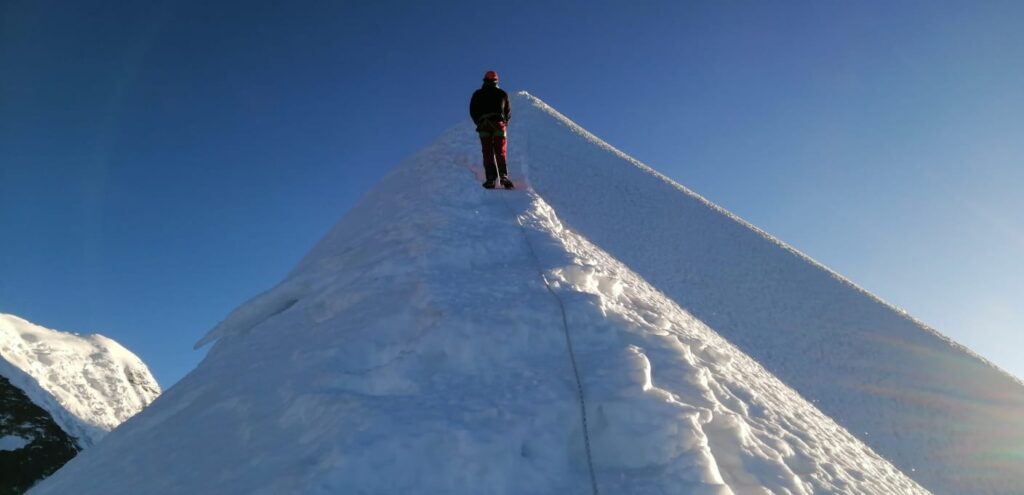
Trip Facts
Maximum Altitude: 6189m / 20305 feet
Technical Level: Trekking Peak
Climb Duration: 1 Day or 7 – 9 hours
Location: Khumbu Region, Nepal
Best Time: March to May and September to November
Outline Itinerary for Island Peak Climbing
Day 1: Fly to Lukla (2,860m) and trek to Phakding (2,610m) – 3-4 hours
Day 2: Trek to Namche Bazaar (3,440m) – 6-7 hours
Day 3: Acclimatization day at Namche Bazaar (3,440m) – Optional hike to Everest View Hotel (3,880m)
Day 4: Trek to Tengboche (3,860m) – 5-6 hours
Day 5: Trek to Dingboche (4,410m) – 5-6 hours
Day 6: Trek to Lobuche (4,910m) – 5-6 hours
Day 7: Trek to Everest Base Camp (5,364m) via Gorakshep (5,164m) and back to Gorakshep – 7-8 hours
Day 8: Hike to Kala Patthar (5,545m) and back to Lobuche (4,910m) – 6-7 hours
Day 9: Trek to Chhukhung (4,730m) via Kongma La Pass (5,540m) – 7-8 hours
Day 10: Trek to Island Peak Base Camp (5,200m) – 3-4 hours
Day 11: Climb Island Peak (6,189m) and descend to Base Camp – 10-12 hours
Day 12: Contingency day (for weather or extra acclimatization)
Day 13: Descend to Pangboche (3,985m) – 6-7 hours
Day 14: Descend to Namche Bazaar (3,440m) – 6-7 hours
Day 15: Descend to Lukla (2,860m) – 6-7 hours
Day 16: Fly back to Kathmandu
Trek Overview
Your expedition begins with a scenic flight from Kathmandu to Lukla, the gateway to the Everest region. From here, your trek officially starts, leading you through picturesque Sherpa villages and rugged mountain trails.
On Day 2, you’ll arrive at Namche Bazaar, the largest Sherpa town in the Everest region. Here, you’ll spend two nights for acclimatization, exploring the vibrant markets, interacting with locals, and enjoying panoramic views of Everest (8,848m), Lhotse, Nuptse, and Ama Dablam.
Continuing the trek, you’ll pass through Tengboche, Dingboche, Lobuche, and Gorakshep, gradually gaining altitude before reaching Everest Base Camp (EBC) and Kala Patthar (5,545m)—the best vantage point for stunning sunrise views of Mount Everest and surrounding peaks.
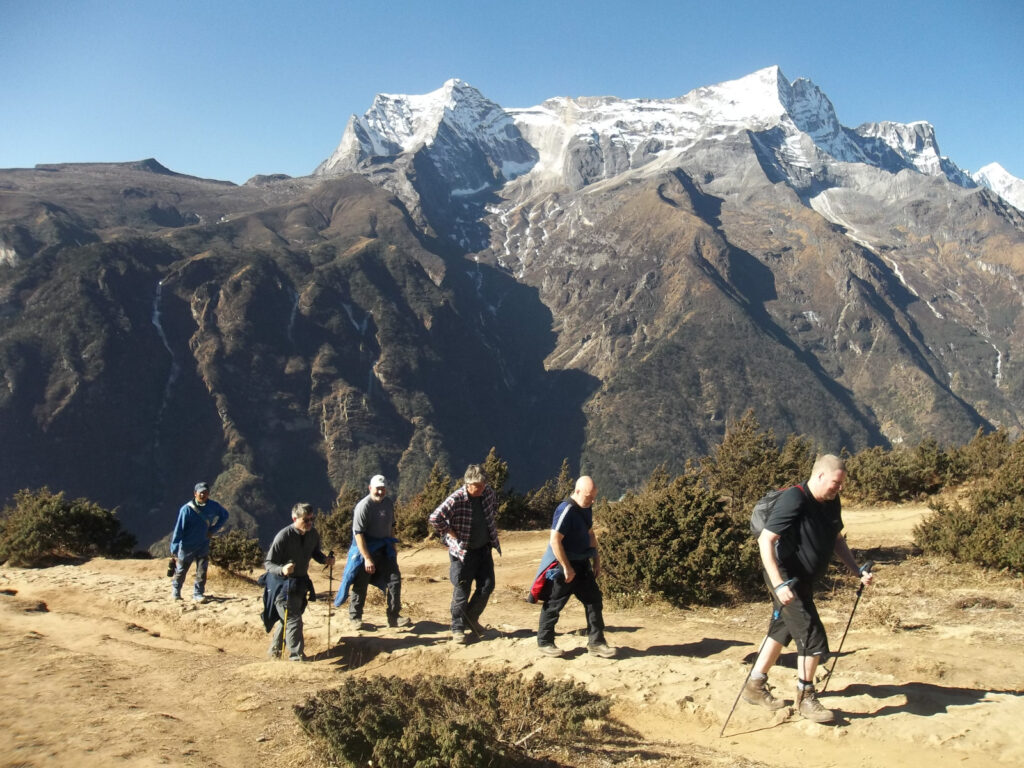
After experiencing the magic of Everest Base Camp, you’ll take on the Kongma La Pass (5,535m)—one of the three high passes of the Everest region—before reaching Chhukung village, the staging point for your Island Peak (6,189m) climbing adventure.
With proper acclimatization and guidance from experienced climbing Sherpas, you’ll make your way to Island Peak Base Camp, preparing for the ultimate challenge—summiting Island Peak, one of Nepal’s most popular trekking peaks.
This adventure is designed for those seeking both a high-altitude trekking experience and an introductory Himalayan climbing challenge, making it the perfect choice for thrill-seekers and aspiring mountaineers.
Difficulty and Health Requirements Island Peak
According to the Alpine Grading System, Island Peak difficulty is rated at a ‘2B’ level. While it is one of the practice peaks that novices are advised to tackle. Climbing Island Peak may be simpler for an experienced climber, but it may be more challenging for a novice or someone with less expertise.
Climbers face a major difficulty due to the thin air at such high altitudes, which causes decreased oxygen levels and higher physical exertion. Acute mountain sickness (AMS) is another risk. It’s vital to regularly acclimatize, stay hydrated, and have an even keel to prevent it.
If you have ever been to trekking such as Manaslu Circuit Trek, you might know how to tackle altitude sickness and the physical challenges you have to face during the journey.
Island Peak climbing becomes even more challenging due to the unpredictability and harshness of the weather in the Everest region.
Even during the climbing season, climbers may experience sub-zero temperatures, heavy winds, and snowfall. The Island Peak journey demands a high degree of physical fitness because it involves several days of hiking and gains in elevation. Exercises that build endurance, such as running, trekking, or cycling, will boost your stamina.
Best Time to Climb Island Peak
It is only appropriate that you familiarize yourself with the time of your trip so that you may make the most of it and maximize your potential. Every season adds a unique flavor to your encounter. Nevertheless, the ideal season for this journey is similar to one of the most popular treks, “Annapurna Circuit Trek”.
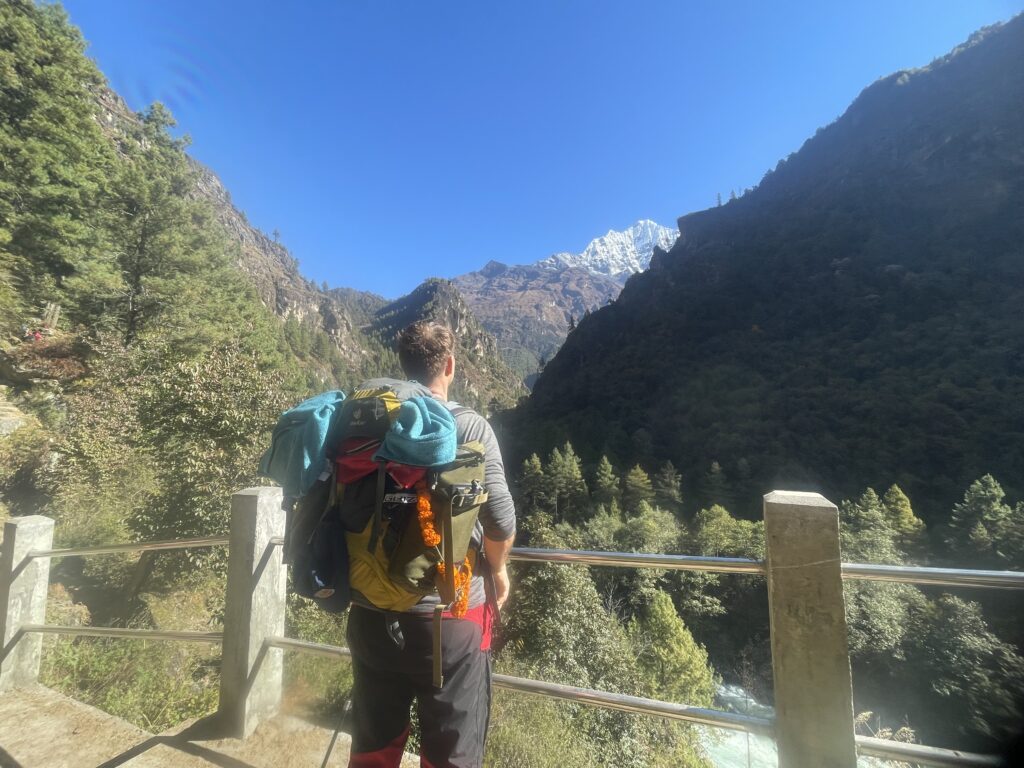
Spring (March to May)
Trekkers who want to summit Island Peak safely, soundly, and successfully should go during the best and most favorable season, which is spring. From March through May, the spring season is in full swing. It brings with it warmer temperatures, which enhances the enjoyment of your summit attempt.
You can take pleasure in the lush, varied wildlife and plants that nature has to offer. Rainfall and snowfall are less likely to occur. The majority of the daytime sky is sunny, with temperatures between 15 and 17 degrees Celsius.
Summer/Monsoon (June to August)
Due to the unfavorable weather, climbing Island Peak during the summer is less popular and considered an additional off-season in Nepal. Warm, humid weather accompanied by cloudy and misty visibility is what the monsoon provides.
Trails become slick and muddy by heavy rains, and elevated risk of floods and landslides. Nonetheless, because it’s off-season, flights and lodging are accessible.
Fall / Autumn (September to November)
September, October, and November are also excellent periods to climb Island Peak during the autumn, with October being the busiest month. Every step is a visual feast throughout the fall foliage and spring’s flowering rhododendrons.
Indra Jatra, Dashain, Tihar, Chatth Puja, Mani Rimdu, and other festivals are celebrated in Nepal during this time of year. You can take part in this festival in addition to your trekking adventure. Snowfall and rain are not likely to occur.
Winter (December to February)
The winter months are the off-season and, because of the unfavorable weather, they are among the most difficult to ascend the Island summit. Noting the extreme weather, heavy snowfall, and increased risk of avalanches and other risks is important.
Not enough lodging options because there aren’t as many available. Having additional gear and equipment packed makes it heavier to carry.
In addition, you may also like to know the best time to travel to Nepal.
Island Peak Climbing – 16 Days - Itinerary
Fly to Lukla (2,860m) and trek to Phakding (2,610m) – 3-4 hours
Day 2: Trek to Namche Bazaar (3,440m) – 6-7 hours
Acclimatization day at Namche Bazaar (3,440m) – Optional hike to Everest View Hotel (3,880m)
Trek to Tengboche (3,860m) – 5-6 hours
Trek to Dingboche (4,410m) – 5-6 hours
Trek to Lobuche (4,910m) – 5-6 hours
Trek to Everest Base Camp (5,364m) via Gorakshep (5,164m) and back to Gorakshep – 7-8 hours
Hike to Kala Patthar (5,545m) and back to Lobuche (4,910m) – 6-7 hours
Trek to Chhukhung (4,730m) via Kongma La Pass (5,540m) – 7-8 hours
Trek to Island Peak Base Camp (5,200m) – 3-4 hours
Climb Island Peak (6,189m) and descend to Base Camp – 10-12 hours
Contingency day (for weather or extra acclimatization)
Descend to Pangboche (3,985m) – 6-7 hours
Descend to Namche Bazaar (3,440m) – 6-7 hours
Descend to Lukla (2,860m) – 6-7 hours
Fly back to Kathmandu
Inclusions
What's included
- International & Domestics Airport pick-up and drop
- 3 Nights Hotel accommodation in Kathmandu (with breakfast included)
- An Experience English speaking guide and porter (1 porter for every 2 trekkers)
- A professional sherpa climbing guide
- Tented camp while on Island Peak Climb.
- All necessary camping equipment, Tent, Table & Chair for climbing expedition's crews.
- Island Peak Climbing group climbing gear, climbing rope, snow bars & carabineers etc.
- All Meals and Teahouse accommodation during the trek with attach deluxe room
- Kathmandu Valley Sightseeing with private jeep and tour guide (Local Monuments entrance fee included)
- Kathmandu to Lukla Flight Ticket (Round Trip)
- All required trekking permits (National Park Entry Fee and Pasang Lhamu Rural Municipality Entry Fee)
- Guide and porter insurance with food and accommodation
- Basic Medical kits
- Sleeping and duffel bag, down jacket, trekking poles (should be returned after the trek)
- Farewell dinner
- Emergency Helicopter Evacuation Service Arrangement Only (should cover by your travel insurance)
- All required paper works and government taxes
- Everest Hikes T-shirt
What's not included
- International Flight
- Nepal Travel Visa Fee
- Personal Medical and Travel insurance (Should cover helicopter evacuation)
- Guide, Porter and Driver tips
- Personal Gears (equipment)
- Personal bill
- Lunch and Dinner in Kathmandu
- All other personal expense of beverages (hard and soft drinks)
- All other things not mentioned in the inclusion
Accommodation and Meals During Island Peak Climbing
Along the trekking route, teahouses and lodges offer the majority of the accommodations for the Island Peak Climbing. After a strenuous day of hiking, guests can unwind at these modest yet cozy teahouses and lodges, which have warm beds and blankets.
In Kathmandu, there are plenty of hotels and lodges to choose from for a nice stay. The cost of lodging in Kathmandu can range from $15 to $250 per night. For most trekkers, accommodations in the trekking zones are their main worry.
Because of the logistical difficulties in delivering supplies to higher altitudes, lodging options get progressively more basic and possibly more costly as you ascend. You also need to spend a few nights in a tent while you are ascending from the Base Camp. So, prepare yourself because you might not get a cozy sleep as you have imagined.
Most of the meals are provided at the teahouses and lodges along the route, which include a variety of Western and Nepali dishes.
You will eat lunch while traveling to your next destination, and you will have dinner and breakfast in the same teahouse or camp where you spent the night. Porridge, eggs, bread, pancakes, tea, or coffee are some common breakfast fare.
Pasta, noodles, potatoes, veggies, and meat dishes are typical lunch and dinner alternatives. Dal Bhat is a combination of rice, lentil soup, and curry.
Required Permits for Island Peak Climbing
Permits are essential for both trekking and climbing activities in Nepal, whether you’re embarking on popular routes like the Everest Base Camp Trek, Langtang Valley Trek, Manaslu Circuit Trek, Lobuche Peak Climbing, or any other adventure. So, you do need to obtain permit for Island Peak Climbing. The Nepal Mountaineering Association (NMA) has designated Island Peak as a Group B trekking peak. Entry-level permits are needed for both climbing and trekking.
Seasons and the governing body in question are two variables that affect the permission fees.
NMA (Nepal Mountaineering Association) Permit
The Nepal Mountaineering Association is the organization that issues the Island Peak climbing permit (NMA). The costs per person for the Island peak permit, depending on the season, are as follows:
- Spring: $250 per person
- Fall (September to November): USD 125 per individual
- Winter (December through February): $70 per individual
- Summertime (June to August): USD 70 per individual
Climbers must also pay a refundable $500 waste deposit to the NMA in addition to the cost of the climbing permit.
Sagarmatha National Park Entry Fee
If you’re planning to climb Island Peak, located in the Khumbu region of Nepal, you will indeed require a permit for Sagarmatha National Park. This is an essential step to ensure that all trekkers and climbers are registered and that the park’s environmental integrity is maintained. Here are some additional details that might help you with obtaining the permit:
Where to Obtain Sagarmatha National Park Permit?
- Kathmandu: You can obtain the Sagarmatha National Park permit at the Nepal Tourism Board office in Kathmandu. This is a convenient option if you are spending a few days in the capital before heading to the mountains.
- Jorsalle: Alternatively, you can obtain the permit at the park entrance in Jorsalle. This might be a practical option if you are heading directly into the Khumbu region without stopping long in Kathmandu.
Costs:
- The cost of the permit varies depending on your nationality. It is generally priced differently for SAARC nationals (countries in the South Asian Association for Regional Cooperation) compared to other international visitors.
Local Area Permit:
You must obtain a local area permit, sometimes called a Khumbu Rural Municipality Entrance permit, before starting your journey to Island Peak. Upon arrival in the Sagarmatha region, namely at Lukla, the local area permit can only be acquired. Each person must pay USD 20 to obtain this permission.
Certain documentation is required when applying for an Island Peak climbing permit.
- Passport-sized pictures
- Forms of application
- Nepali Rupees (NPR) to cover the cost of the permission
- A copy of your passport
- Insurance for travel
Equipment List and Packing List
Before beginning the trip, one should prepare the required packing list for the trip. Considering on Island Peak Climbing, you should bring both trekking and climbing equipment for Island Peak Climbing.
For a detail list of trekking gears, click here.
Climbing Gears
It is essential to have the right equipment for a safe and successful ascent while starting an Island Peak climbing excursion. Securing protection against the harsh alpine environment is as important as improving comfort and performance with the appropriate gear.
- Prusik Cord
- Crampons
- Descender and Ascender
- A Climbing Brace
- A harness
- Carabiners and their locking mechanism
- An ice axe
- Climbing Sling
- A helmet for climbing
- Mountaineering footwear
These are some of the most vital pieces of equipment that you will need for your ascent.
Travel Insurance
While mountaineering, there’s always a chance of things going wrong, even if you’ll be guided by the best pros available. Whether you’re doing the Island Peak climb or any other of our trekking adventures, you are always advised to get specialized travel insurance.
The majority of the dangers involved in trekking in Nepal can be covered by travel insurance. Not only does travel insurance protect you against geographical dangers, but it also makes your trip to Nepal less stressful.
Evacuation will be exceedingly costly in an emergency if you do not have adequate travel insurance. Thus, pick insurance that includes helicopter evacuation as well as emergency and medical recovery.
You may like to read Essential Guide to Choosing Travel Insurance for High-Altitude Climbing in Nepal

